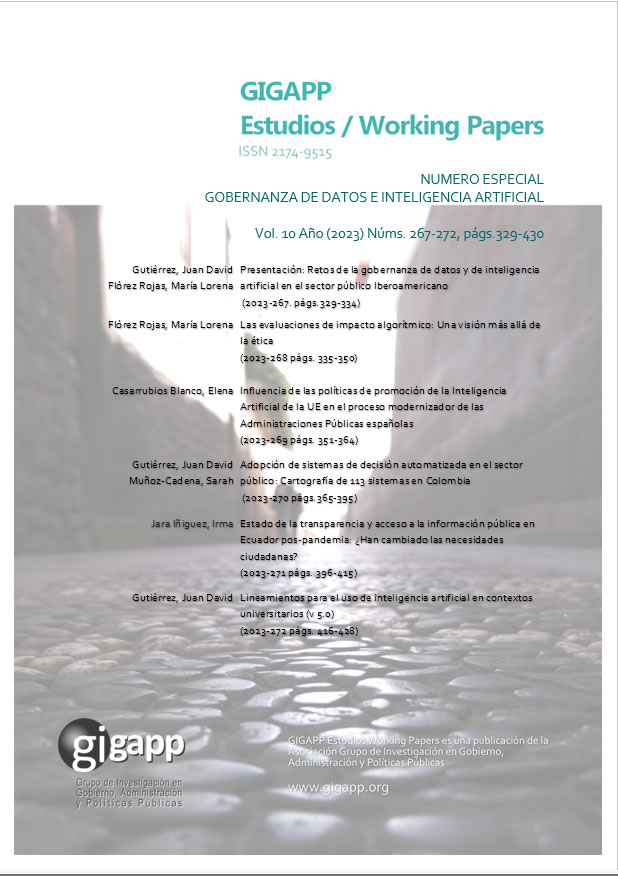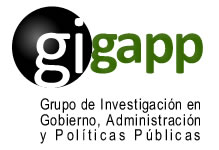Las evaluaciones de impacto algorítmico: Una visión más allá de la ética
Resumen
Los sistemas que utilizan la inteligencia artificial (IA) serán la norma del futuro. Sin embargo, la intervención humana es crucial a la hora de considerar las cuestiones éticas y legales basadas en los juicios de estos sistemas. La preocupación es sobre cómo usar, desarrollar e investigar la IA con un enfoque social a través de los análisis de impacto algorítmico (AIA). Esta metodología contribuye a una evaluación de los posibles riesgos asociados de la IA. Todas las organizaciones pueden aprovechar esta metodología para aumentar la confianza en las aplicaciones de IA. A pesar del esfuerzo por integrar estas estrategias de autorregulación, en algunas industrias, los principios éticos se quedan cortos en su aplicación. El documento analiza la metodología de AIA y del beneficio social a partir del análisis de un toolkit ético legal que se testeó para hacer un llamado a los reguladores a concretar reglas y estándares sobre las implicaciones de esta tecnología.
Descargas
Citas
Baum, S. D. (2020) ‘Social choice ethics in artificial intelligence’, AI and Society. Springer, 35(1), pp. 165–176. doi: 10.1007/s00146-017-0760-1.
Benjamins, R., Barbado, A. and Sierra, D. (2019) ‘Responsible AI by Design in Practice’, in Proceedings of the Human-Centered AI: Trustworthiness of AI Models & Data (HAI) track at AAAI Fall Symposium., p. 10. Available at: https://arxiv.org/abs/1909.12838 (Accessed: 23 August 2021).
Bhuiyan, J. (2021) ‘LAPD ended predictive policing programs amid public outcry. A new effort shares many of their flaws’, The Guardian. Available at: https://www.theguardian.com/us-news/2021/nov/07/lapd-predictive-policing-surveillance-reform (Accessed: 2 September 2022).
Borges, J. V. (2017) ‘Robots and the military: A strategic view’, Intelligent Systems, Control and Automation: Science and Engineering. Kluwer Academic Publishers, 84, pp. 199–205. doi: 10.1007/978-3-319-46667-5_15/COVER.
Castets-Renard, C. (2021) ‘Human Rights and Algorithmic Impact Assessment for Predictive Policing’, Cambridge University Press, pp. 93–110. Available at: https://papers.ssrn.com/abstract=3890283 (Accessed: 1 September 2022).
CIFRA (2020) AICan 2020 CIFAR Pan-Canadian AI Strategy Impact Report. Available at: https://cifar.ca/wp-content/uploads/2020/11/AICan-2020-CIFAR-Pan-Canadian-AI-Strategy-Impact-Report.pdf.
Davis, J. et al. (2022) ‘Five ethical challenges facing data-driven policing’, AI and Ethics 2022 2:1. Springer, 2(1), pp. 185–198. doi: 10.1007/S43681-021-00105-9.
Decker, M. and Ladikas, M. (2004) ‘Technology Assessment in Europe; between Method and Impact — The TAMI Project’, in Bridges between Science, Society and Policy. Springer Berlin Heidelberg, pp. 1–10. doi: 10.1007/978-3-662-06171-8_1.
Dulce, M., Ramírez-Amaya, S. and Riascos, Á. (2018) ‘Efficient allocation of law enforcement resources using predictive police patrolling’, in NIPS 2018 Workshop on Machine Learning for the Developing World. doi: 10.48550/arxiv.1811.12880.
Florez Rojas, M. L. (2021) Toolkit Ético Legal, GECTI Uniandes. Available at: https://gecti.uniandes.edu.co/qsm_quiz/toolkit-etico-legal-es/ (Accessed: 2 September 2022).
Flórez Rojas, M. L. et al. (2022) La adopción de tecnologías disruptivas en las organizaciones a partir de la creación e implementación de un toolkit ético-legal. Bogotá. doi: 10.1007/s11948-019-00146-8.
Flórez Rojas, M. L. (2023) ‘Pensamiento de diseño y marcos éticos para la Inteligencia Artificial: una mirada a la participación de las múltiples partes interesadas’, Desafíos. Colegio Mayor de Nuestra Senora del Rosario, 35(1). doi: 10.12804/REVISTAS.UROSARIO.EDU.CO/DESAFIOS/A.12183.
Floridi, L. (2019) ‘Translating principles into practices of digital ethics: five risks of being unethical’, Philos. Technol. Springer Netherlands, 32(2), pp. 185–193. doi: 10.1007/s13347-019-00354-x.
Gobierno de Canadá (2021) Responsible use of artificial intelligence (AI). Available at: https://www.canada.ca/en/government/system/digital-government/digital-government-innovations/responsible-use-ai.html#toc1 (Accessed: 25 August 2021).
Gobierno de Colombia (2022) Marco ético para la Inteligencia Artificial. Available at: https://iaeticacolombia.gov.co/ (Accessed: 25 August 2021).
Guío Español, A. (2021) Consejo Internacional de Inteligencia Artificial para Colombia. Available at: https://dapre.presidencia.gov.co/TD/CONSEJO-INTERNACIONAL-INTELIGENCIA-ARTIFICIAL-COLOMBIA.pdf.
Kaminski, M. E. and Malgieri, G. (2020) ‘Multi-layered Explanations from Algorithmic Impact Assessments in the GDPR’, Proceedings of the 2020 Conference on Fairness, Accountability, and Transparency. New York, NY, USA: ACM. doi: 10.1145/3351095.
Leikas, J., Koivisto, R. and Gotcheva, N. (2019) ‘Ethical Framework for Designing Autonomous Intelligent Systems’, Journal of Open Innovation: Technology, Market, and Complexity Article, 5(18), p. 12. doi: 10.3390/joitmc5010018.
Mantelero, A. (2018) ‘AI and Big Data: A blueprint for a human rights, social and ethical impact assessment’, Computer Law & Security Review. Elsevier Advanced Technology, 34(4), pp. 754–772. doi: 10.1016/J.CLSR.2018.05.017.
Manthorpe, R. (2017) ‘The Beauty.AI robot beauty contest is back’, WIRED-Business. Available at: https://www.wired.co.uk/article/robot-beauty-contest-beauty-ai (Accessed: 17 May 2023).
Metcalf, J. et al. (2021) ‘Algorithmic Impact Assessments and Accountability: The Co-construction of Impacts CCS CONCEPTS’, in ACM Conference on Fairness, Accountability, and Transparency (FAccT ’21). New York, NY, USA: ACM, pp. 735–746. doi: 10.1145/3442188.
Mintrom, M. and Luetjens, J. (2016) ‘Design Thinking in Policymaking Processes: Opportunities and Challenges’, Australian Journal of Public Administration. John Wiley & Sons, Ltd, 75(3), pp. 391–402. doi: 10.1111/1467-8500.12211.
Mittelstadt, B. (2019) ‘Principles alone cannot guarantee ethical AI’, Nat. Mach. Intell. Springer Science and Business Media LLC, 1(11), pp. 501–507. doi: 10.1038/s42256-019-0114-4.
Moss, E. et al. (2020) ‘Governing with Algorithmic Impact Assessments: Six Observations’, SSRN Electronic Journal. Elsevier BV. doi: 10.2139/SSRN.3584818.
Moss, E. et al. (2021) ‘Assembling Accountability: Algorithmic Impact Assessment for the Public Interest’, SSRN Electronic Journal. Elsevier BV. doi: 10.2139/SSRN.3877437.
Munn, L. (2022) ‘The uselessness of AI ethics’, AI and Ethics 2022. Springer, pp. 1–9. doi: 10.1007/S43681-022-00209-W.
NIST (2022) AI Risk Management Framework: Second Draft Notes for Reviewers. Available at: https://www.nist.gov/system/files/documents/2022/08/18/AI_RMF_2nd_draft.pdf (Accessed: 18 May 2023).
Novelli, C., Taddeo, M. and Floridi, L. (2023) ‘Accountability in artificial intelligence: what it is and how it works’, AI and Society. Springer Science and Business Media Deutschland GmbH, 1, pp. 1–12. doi: 10.1007/S00146-023-01635-Y/FIGURES/1.
OECD (2019) Artificial Intelligence in Society, Artificial Intelligence in Society. Paris: OECD. doi: 10.1787/eedfee77-en.
OECD (2023) Fundamental Rights and Algorithms Impact Assessment (FRAIA), Catalogue of Tools & Metrics for Trustworthy AI. Available at: https://oecd.ai/en/catalogue/tools/fundamental-rights-and-algorithms-impact-assessment-%28fraia%29 (Accessed: 17 May 2023).
OPSI (2023) Algorithmic Impact Assessment - Observatory of Public Sector Innovation. Available at: https://oecd-opsi.org/toolkits/algorithmic-impact-assessment/ (Accessed: 17 May 2023).
Reisman, D. et al. (2018) Algorithmic Impact Assessments: A practical framework for public agency accountability. Available at: https://ainowinstitute.org/publication/algorithmic-impact-assessments-report-2 (Accessed: 26 April 2023).
Rességuier, A. and Rodrigues, R. (2020) ‘AI ethics should not remain toothless! A call to bring back the teeth of ethics’:, Big Data & Society. SAGE PublicationsSage UK: London, England, 7(2). doi: 10.1177/2053951720942541.
Selbst, A. D. (2021) ‘An Institutional View of Algorithmic Impact Assessments’, Harvard Journal of Law & Technology (Harvard JOLT), 35.
Uchida, C. D. and Swatt, M. L. (2013) ‘Operation LASER and the Effectiveness of Hotspot Patrol: A Panel Analysis’:, Police Quarterly. SAGE PublicationsSage CA: Los Angeles, CA, 16(3), pp. 287–304. doi: 10.1177/1098611113497044.
UNESCO (2021) Recommendation on the Ethics of Artificial Intelligence. Paris. Available at: https://unesdoc.unesco.org/ark:/48223/pf0000381137 (Accessed: 18 May 2023).
Young, M. M., Bullock, J. B. and Lecy, J. D. (2019) ‘Artificial Discretion as a Tool of Governance: A Framework for Understanding the Impact of Artificial Intelligence on Public Administration’, Perspectives on Public Management and Governance. Oxford Academic, 2(4), pp. 301–313. doi: 10.1093/PPMGOV/GVZ014.
Youth Laboratories (2016) Beauty.AI 1.0. Available at: https://www.beauty.ai/#what (Accessed: 17 May 2023).
Derechos de autor 2023 María Lorena Flórez Rojas, Dra. (Autor/a)

Esta obra está bajo licencia internacional Creative Commons Reconocimiento-NoComercial-CompartirIgual 4.0.
Aquellos autores/as que tengan publicaciones con esta revista, aceptan los términos siguientes:
a. Los autores/as conservarán sus derechos de autor y garantizarán a la revista el derecho de primera publicación de su obra, el cuál estará simultáneamente sujeto a la Licencia de reconocimiento de Creative Commons Attribution-NonCommercial-ShareAlike 4.0 International (CC BY-NC-SA 4.0) que permite a terceros compartir la obra siempre que se indique su autor y su primera publicación esta revista.
Con esta licencia de acceso abierto, los lectores (usuarios) pueden:
- Compartir — copiar y redistribuir el material en cualquier medio o formato
- Adaptar — remezclar, transformar y construir a partir del material
Bajo los siguientes términos:
-
Atribución — usarios deberán dar crédito de manera adecuada, brindar un enlace a la licencia, e indicar si se han realizado cambios. Puede hacerlo en cualquier forma razonable, pero no de forma tal que sugiera que usted o su uso tienen el apoyo de la licenciante.
-
NoComercial — usuarios no puede hacer uso del material con propósitos comerciales.
-
CompartirIgual — Si remezcla, transforma o crea a partir del material, usuarios deben distribuir su contribución bajo la misma licencia del original.
-
Sin restricciones adicionales: los usuarios no pueden aplicar términos legales o medidas tecnológicas que restrinjan legalmente a otros de hacer cualquier cosa que permita la licencia.
b. Los autores/as podrán adoptar otros acuerdos de licencia no exclusiva de distribución de la versión de la obra publicada (p. ej.: depositarla en un archivo telemático institucional o publicarla en un volumen monográfico) siempre que se indique la publicación inicial en esta revista
c. Se permite y recomienda a los autores/as difundir su obra a través de Internet (p. ej.: en archivos telemáticos institucionales o en su página web) antes y durante el proceso de envío, lo cual puede producir intercambios interesantes y aumentar las citas de la obra publicada. (Véase El efecto del acceso abierto).



